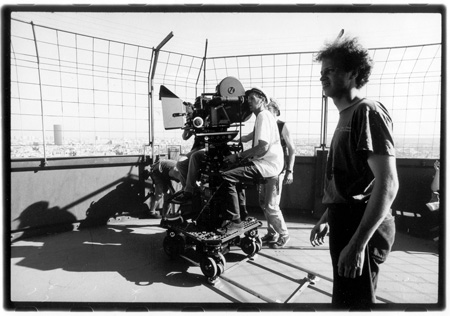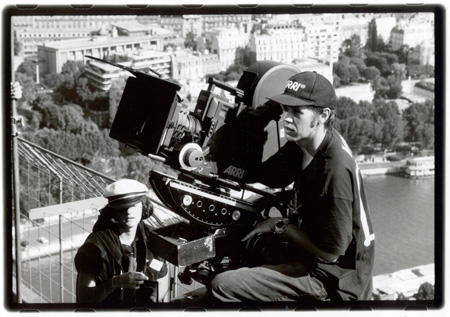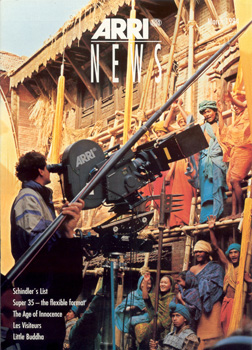On Location in Paris with ARRI 765
|
Read more
at in70mm.com The 70mm Newsletter |
| Written by: Veit Helmer | Date: 29.03.2008 |
 Director
Veit Helmer on top of the Eiffel Tower in Paris directing his 65mm short
film "Tour Eiffel". Picture from Veit Helmer Director
Veit Helmer on top of the Eiffel Tower in Paris directing his 65mm short
film "Tour Eiffel". Picture from Veit HelmerThe idea of filming in 70mm had always seemed to me to be an unattainable dream. But thanks to two prizes which I won for my short films "Zurn Greifen Nah" (Near Enough to Touch) and "Der Fensterputzer" (The Window Cleaner) this dream became a reality. I had brightly-coloured postcards whirling around in my head. I wanted to shoot a film on the Eiffel Tower: A car lover can do nothing but watch from the Eiffel Tower as his new car is stolen and written off. For the photography I got Joachim Jung back from Hollywood; he had already photographed my short film "Der Fensterputzer" in the wide-screen format. As first camera assistant I was able to get hold of the French woman Sylvie Vienne who had already worked on a 3-D production with the ARRIFLEX 765. Our camera equipment consisted of a complete 765 outfit and one set of lenses (II optics, from 30mm to 350mm). We filmed on Eastman 5297. |
More
in 70mm reading: Distribution of German 70mm short Interview With Otto Blaschek - The Making of ARRI 765 Internet link: |
 Director
of photography on top of the Eiffel Tower in Paris photographing short
film "Tour Eiffel" in 65mm. Picture from Veit Helmer Director
of photography on top of the Eiffel Tower in Paris photographing short
film "Tour Eiffel" in 65mm. Picture from Veit Helmer1st August [1993, ed] was the start of shooting. After the first take directly in front of the Arc de Triomphe I was happy and at the same time disappointed. Maybe I had secretly been hoping that the earth would shake when you shot in 65mm. Instead shooting went as usual. The 765 looks and runs like any 35mm camera. Even the exterior of the 765 is hardly different from a 35mm camera. It even uses the same matte box. Admittedly, the camera is heavier (32 kg with film), but with the help of an additional assistant adjustments didn't take much longer than usual. Only the Magnum dolly turned out to be not stable enough for the weight and sprang back slightly when it was broked fast. In setting the exact camera position the Mamiya director's viewfinder was a distinct help as the camera lenses could be tried out on it beforehand. As we wanted to film several shots with a very long focal length from the Eiffel Tower we used the 350mm lens with an extender. For one extremely long shot we were even able to get accept able results by using two Mutars, although three turned out to be too many. In my opinion an extremely long-range telephoto lens would be a good addition to the otherwise complete range of lenses. In order not to lose the negative's high resolution, all cinema copies should be taken directly from the edited original negative. Any trick work during the duplicate process was therefore impossible. As the story necessitated subjective views through a telescope and a camera, ARRI-Austria produced camera masks which the camera assistant stuck with special adhesive directly in front of the film gate. Through the closeness to the film plane a greater sharpness of the masks was attained. |
|
 This
article was printed in ARRI News in fall of 1994 This
article was printed in ARRI News in fall of 1994A dream sequence, involving cars turning around in the main actor's face was also able to be filmed directly by the camera by using old-fashioned double-exposure. By doing this we were able not only to avoid duplicates but also cut costs. Even at 100 fps the 765 ran without a hitch. Of course it took some time before the camera reached the desired speed. But that's understandable with so much film mass. This was also the first time we heard the motor, and we suddenly realised how quiet the camera actually runs at normal speed. But the biggest surprise came when we looked at the rushes from the slow-motion sequences. These were noticeable for their image stability. They looked no different from the other shots. The bright finder image also made the cameraman's job easier. The illuminated finder frame which was designed for night time shots was sometimes too bright for the dark scenes. An adjustment possibility should be developed for it. Contrary to all expectations, filming was unspectacular as regards working with the camera. We didn't have to forego any complicated shots, nor make any compromises on viewpoints. And even after 10 days' filming and several thousand meters of exposed negative film, we couldn't find either a speck of dust on the film gate or a scratch on the negative. PS: The film has just been completed and will open in August 1994 as a short film in German cinemas. Veit Helmer |
|
|
Go: back
- top - back issues
- news index Updated 21-01-24 |
|
